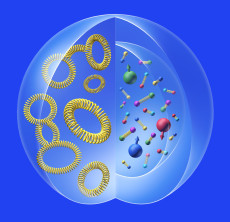Gravitational Form Factors Illuminate Substructure of the Proton
Science Highlight
July 15, 2024

For the first time, researchers have a better understanding of how gluons (left side) and quarks (right side) form the substructure of protons and other hadrons. (Credit: Kent Leech for Berkeley Lab)
Science Breakthrough
Using simulations performed on NERSC’s Perlmutter system, a team of researchers from Fermi National Laboratory; the Massachusetts Institute of Technology; the University of California, Berkeley; and the Nuclear Science Division at Lawrence Berkeley National Laboratory (Berkeley Lab) used lattice quantum chromodynamics (lattice QCD) to understand for the first time certain aspects of proton structure in terms of its fundamental quark and gluon constituents. Lattice QCD is a computational approach to measuring quantities in hadronic physics using a four-dimensional lattice. Their research was recently published in Physical Review Letters.
Science Background
For decades, scientists have known that protons and other hadrons have a substructure of quarks and gluons, and were able to understand the distribution of charge within the proton using electromagnetic form factors. However, the distribution of other physical properties of the proton, like its mass, its spin, its internal forces, and how they are split between quarks and gluons, have been less well understood. All of that information is encoded in the gravitational form factors of hadrons, which have been challenging to measure.
In recent years, some of the gravitational form factors of the proton have been experimentally measured for the first time; in this paper, the researchers gained a better understanding of how energy, angular momentum, pressure, and shear forces are distributed inside the proton by calculating the full set of its gravitational form factors for the first time. In doing so, using lattice QCD, they showed that the gluons inside the proton are more spread out than the quarks, corresponding to a larger “gluonic” than quark radius.
This new information answers long-standing essential questions about the substructure of protons as well as pointing researchers toward more targeted questions about other hadrons.
Science Breakdown
The researchers performed their calculations on NERSC’s Perlmutter system using Chroma and QUDA, parts of a suite of software produced by NVIDIA and the USQCD collaboration of U.S. scientists developing HPC tools for lattice QCD. The project, “The gluonic structure, pressure, and shear distributions of the nucleon,” (PI: Shanahan) used 552,000 GPU hours on Perlmutter.
Because the data for measuring the contributions of the quarks and gluons was both very complex and very noisy, the team generated a statistical sample of over four million measurements. Each measurement was computationally intensive, and was made feasible by the power of Perlmutter’s GPUs.
Co-authors
Daniel Hackett - Fermilab
Dimitra A. Pefkou - Nuclear Science Division, Lawrence Berkeley National Laboratory; University of California, Berkeley
Phiala E. Shanahan - Massachusetts Institute of Technology
Publication
Daniel C. Hackett, Dimitra A. Pefkou, and Phiala E. Shanahan
Phys. Rev. Lett. 132, 251904 – Published 21 June 2024.
DOI: https://doi.org/10.1103/PhysRevLett.132.251904
Funding
DOE Office of Science, Office of Nuclear Physics
User Facilities
NERSC
About NERSC and Berkeley Lab
The National Energy Research Scientific Computing Center (NERSC) is a U.S. Department of Energy Office of Science User Facility that serves as the primary high performance computing center for scientific research sponsored by the Office of Science. Located at Lawrence Berkeley National Laboratory, NERSC serves almost 10,000 scientists at national laboratories and universities researching a wide range of problems in climate, fusion energy, materials science, physics, chemistry, computational biology, and other disciplines. Berkeley Lab is a DOE national laboratory located in Berkeley, California. It conducts unclassified scientific research and is managed by the University of California for the U.S. Department of Energy. »Learn more about computing sciences at Berkeley Lab.







